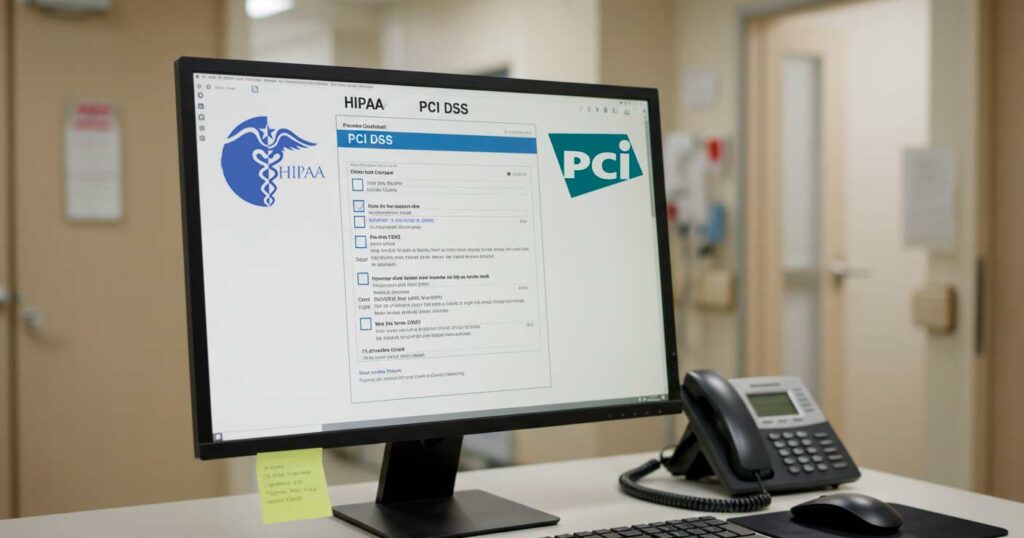Third party risk assessment evaluates security, compliance, and operational risks from external vendors and service providers. As businesses rely more on third party vendors, these relationships create new attack vectors that cybercriminals actively exploit.
Recent data shows vendor-related security incidents cause over one-third of all data breaches. When third party vendors experience security incidents, the impact affects every business in their network. This makes third party risk assessment essential for modern cybersecurity.
Organizations face growing regulatory pressure to oversee third party relationships properly. The Digital Operational Resilience Act requires financial institutions to maintain vendor risk management programs. Healthcare organizations must ensure HIPAA compliance across business associates.
This guide provides a complete framework for implementing effective third party risk assessment programs. You will learn to identify high risk vendors, conduct vendor assessments, and maintain ongoing monitoring that protects against vendor-related threats.
Key Takeaways
- Third party risk assessment is essential as vendor-related incidents cause over one-third of all data breaches.
- Effective programs classify vendors into high risk, medium risk, and low risk categories based on data access and business importance.
- Due diligence processes must examine security controls, regulatory compliance, and business continuity to mitigate risks from cyber threats.
- Supply chain visibility requires fourth-party risk assessment to maintain a complete picture of all operational dependencies.
- Security teams must coordinate with stakeholders to balance third party vendor security risks with business requirements.
- Relevant Compliance helps organizations streamline assessments and maintain compliance across their third party risk program.
Get Compliant. Stay Compliant.
Whether you’re just starting your compliance journey or preparing for your official assessment, our platform is your compliance center.
Understanding Third Party Risk Assessment Fundamentals
What is Third Party Risk Assessment?
Third party risk assessment is a structured process that identifies, analyzes, and quantifies risks from external organizations. This process examines vendor security controls, business continuity plans, financial stability, and regulatory compliance practices to determine the overall risk level of each third party relationship.
The assessment differs from standard vendor evaluations by focusing specifically on risk factors that could impact your organization. While vendor assessments might evaluate service quality or pricing, third party risk assessment examines security vulnerabilities, compliance gaps, and operational weaknesses that could create business disruption.
Vendor Risk Assessment vs Party Risk Assessment
Vendor risk assessment and third party risk assessment are often used interchangeably, though vendor risk assessment typically focuses more narrowly on commercial suppliers. Third party risk assessment encompasses a broader range of external relationships, including contractors, consultants, business partners, and service providers who may not have traditional vendor contracts.
These assessments form the foundation of comprehensive third party risk management programs. The assessment provides point-in-time evaluation, while the broader program includes ongoing monitoring, incident response, and continuous risk mitigation activities.
Party Vendor Risk Assessment Programs
Party risk assessment refers to any systematic evaluation of risks introduced by external parties, whether they are vendors, partners, or other business associates. A well-structured party vendor risk assessment creates accountability and enables consistent evaluation across all external relationships.
Types of Third Party Risk
Security risks represent the most visible category of third party risk, encompassing vulnerabilities in vendor systems that could provide attackers with access to your network or data. These risks include weak access controls, unpatched software, inadequate encryption, and poor incident response capabilities.
Cyber Threats and Data Breaches
Data breaches at third party vendors pose particular concern because organizations often have limited visibility into vendor security practices. When sensitive data is compromised at a vendor location, your organization faces the same regulatory consequences and customer impact as if the breach occurred in your own systems.
Cyber threats targeting your vendors can quickly spread to your organization through shared systems, data exchanges, or network connections. Organizations must implement comprehensive controls to mitigate risks effectively across their vendor ecosystem.
Regulatory Compliance and Due Diligence
Compliance risks arise when third party vendors fail to maintain alignment with regulatory requirements that govern your industry. Due diligence becomes essential for verifying vendor compliance capabilities before establishing business relationships, particularly when vendors operate across multiple jurisdictions with varying regulatory requirements.
Healthcare Industry: Organizations must verify that business associates comply with HIPAA requirements for protecting protected health information, including implementing appropriate administrative, physical, and technical safeguards.
Financial Services: Institutions risk regulatory sanctions when vendors cannot demonstrate adequate controls under frameworks like the Sarbanes-Oxley Act (SOX), Gramm-Leach-Bliley Act, and the Digital Operational Resilience Act, which requires comprehensive oversight of technology vendors.
Payment Processing: Vendors must maintain PCI DSS compliance to handle credit card data securely, regardless of industry.
International Operations: European GDPR requirements, Canadian privacy laws, and various national data sovereignty requirements create additional compliance complexity for global vendor relationships.
Supply Chain and Business Continuity Risks
Operational risks affect business continuity and service delivery capabilities. Vendor outages, capacity limitations, or service disruptions can prevent your organization from meeting customer commitments or maintaining normal operations. Supply chain disruptions, natural disasters, or vendor financial instability can create cascading effects that impact multiple business functions simultaneously.
Financial risks include direct monetary losses from vendor relationships, but also indirect costs from operational disruptions, regulatory penalties, or reputational damage. Vendor financial instability can lead to service interruptions or data loss if providers cease operations without proper transition planning.
The Third Party Risk Assessment Process
Step 1: Identify and Classify Vendors
Building a comprehensive vendor inventory is the first step in any third party risk assessment program. This inventory must capture all external relationships that access your systems, handle your data, or support critical business functions. Many organizations discover they have hundreds or thousands of vendor relationships when they begin this cataloging process.
Vendor Discovery and Documentation
Start by reviewing accounts payable records, contract management systems, and procurement databases to identify active vendor relationships. Interview department heads and business unit leaders to uncover shadow IT relationships and informal vendor arrangements that may not appear in formal systems.
Security teams should scan network logs and access control systems to identify external connections that may represent undocumented vendor relationships. This comprehensive approach ensures no significant vendor relationships are overlooked during the assessment process.
Risk Classification Methods
Risk classification methods help prioritize assessment efforts by focusing resources on the most significant threats. The most common approach uses a three-tier system that classifies vendors as high risk, medium risk, or low risk based on their access to sensitive data and their importance to business operations.
High risk vendors typically include cloud service providers, payment processors, IT service providers, and any vendor with access to regulated data. These critical vendors require comprehensive assessments that examine security controls, compliance practices, and business continuity plans with annual reassessments and continuous monitoring.
Medium risk vendors include professional services firms, marketing agencies, and specialty software providers that may access some sensitive data but are not critical to core operations. These vendors typically undergo periodic assessments every two to three years with automated monitoring for security incidents.
Low risk vendors include facilities management, office suppliers, and other service providers with minimal access to systems or data. These relationships typically require only basic due diligence checks and periodic review of contract terms and insurance coverage.
Critical vendors represent a subset of high risk vendors that are essential to business operations, requiring the most stringent oversight including on-site assessments, detailed business continuity planning, and regular executive-level review.
Step 2: Assessment Planning and Preparation
Assessment planning begins with defining the scope and depth of evaluation required for each vendor relationship. High risk and critical vendors require comprehensive assessments that examine multiple risk categories, while low risk vendors may only need basic security and compliance verification.
Security Questionnaires and Frameworks
Security questionnaires form the backbone of most vendor assessments, providing a standardized method for evaluating vendor practices across key risk areas. Popular frameworks include the Standardized Information Gathering (SIG) questionnaire, the Cloud Security Alliance Consensus Assessments Initiative Questionnaire (CAIQ), and industry-specific templates like HECVAT for higher education.
Organizations should customize these standard questionnaires to address specific regulatory requirements and internal security policies. Healthcare organizations need questions about HIPAA compliance and protected health information handling. Financial services firms require questions about SOX controls and financial data protection.
Documentation and Certification Requirements
Due diligence requirements extend beyond questionnaires to include review of vendor certifications, audit reports, and security documentation. SOC 2 Type II reports provide detailed information about vendor security controls and their effectiveness over time. ISO 27001 certifications demonstrate commitment to information security management systems.
The assessment process should define clear expectations for vendor participation, including response timeframes, required documentation, and follow-up procedures for identified gaps. Organizations should establish realistic timelines that allow for thorough evaluation without creating unnecessary delays.
Step 3: Conducting Risk Assessments
Data collection methods vary based on vendor risk levels and assessment requirements. High risk vendors typically complete detailed security questionnaires, provide supporting documentation, and may participate in on-site assessments or virtual interviews. Medium risk vendors might complete abbreviated questionnaires with selective documentation review.
Vendor Assessment Techniques
The assessment process should include structured interviews with key vendor personnel to clarify questionnaire responses and explore areas of concern. Technical interviews with vendor security teams can provide deeper insights into security architecture and incident response capabilities.
Vendor assessment techniques should combine self-reported information with independent verification wherever possible. Security questionnaires provide vendor perspectives on their practices, but third-party certifications and audit reports offer independent validation.
Ongoing Monitoring Implementation
Ongoing monitoring extends the assessment process beyond initial evaluation to include continuous risk tracking throughout the vendor relationship. This monitoring should include automated alerts for security incidents, compliance violations, or changes in vendor ownership or financial status.
Regular reassessment schedules ensure that vendor risk evaluations remain current as threats evolve and vendor practices change. Critical vendors typically require annual reassessments, while lower risk vendors might be reassessed every two to three years.
Step 4: Risk Analysis and Evaluation
Identifying risks requires systematic analysis of vendor responses, supporting documentation, and external risk indicators. This analysis should examine gaps between vendor practices and your organization’s security requirements, compliance standards, and risk tolerance levels.
Risk Identification and Gap Analysis
Common risk categories include inadequate access controls, insufficient encryption, weak incident response plans, and gaps in regulatory compliance. Potential risks extend beyond current vulnerabilities to include emerging threats and changing business conditions.
Vendors expanding into new markets may face additional regulatory requirements. Technology changes might create new security vulnerabilities. Economic conditions could affect vendor financial stability or their ability to maintain security investments.
Risk Level Determination and Mitigation
Risk level determination requires consistent scoring methodologies that enable comparison across vendors and risk categories. Many organizations use numerical scoring systems that rate vendor practices against specific criteria, with aggregate scores determining overall risk levels.
Managing third party risks involves developing mitigation strategies that address identified gaps while maintaining business relationships. Risk mitigation options include contractual requirements for security improvements, additional monitoring and oversight, cyber insurance requirements, or limitations on data access.
The risk evaluation process should produce clear, actionable recommendations that enable informed decision-making by business stakeholders. These recommendations should balance risk considerations with business requirements, cost implications, and timeline constraints.
Get Compliant. Stay Compliant.
Whether you’re just starting your compliance journey or preparing for your official assessment, our platform is your compliance center.
Essential Components of Vendor Risk Assessment
Security Controls and Posture Evaluation
Evaluating a vendor’s security posture requires examining their comprehensive approach to information security, including governance, technical controls, and operational practices. This assessment goes beyond checking for the presence of security policies to understanding how effectively these controls are implemented and maintained.
The vendor’s security posture evaluation should examine their security governance structure, including designated security roles, board oversight, and executive accountability for security outcomes. Organizations need to understand how vendors allocate security resources, manage security investments, and respond to emerging threats.
Technical Security Controls Assessment
Technical security controls form the foundation of any security posture assessment. These controls include network security architecture, endpoint protection systems, identity and access management, data encryption practices, and vulnerability management programs. Vendors should demonstrate not only that these controls exist but that they are properly configured and effectively monitored.
Access control represents one of the most critical security control categories in vendor assessments. Organizations must verify that vendors implement appropriate authentication mechanisms, maintain proper user provisioning and deprovisioning processes, and enforce the principle of least privilege access.
Data Protection and Encryption Standards
Data protection controls ensure that vendors properly safeguard sensitive information throughout its lifecycle. This includes encryption of data at rest and in transit, secure data disposal practices, data loss prevention systems, and backup and recovery procedures. Vendors handling regulated data must demonstrate compliance with specific data protection requirements such as GDPR, HIPAA, or PCI DSS standards.
Compliance and Regulatory Assessment
Regulatory compliance assessment ensures that vendors meet all applicable legal and regulatory requirements that govern your organization’s industry. This assessment must consider both direct regulatory requirements that apply to the vendor’s operations and indirect requirements that flow down from your organization’s compliance obligations.
Digital Operational Resilience Act Requirements
The Digital Operational Resilience Act exemplifies the growing regulatory focus on third party risk management in financial services. This regulation requires financial institutions to maintain comprehensive oversight of their technology vendors, including detailed risk assessments, business continuity planning, and incident response coordination.
Healthcare organizations must verify that business associates comply with HIPAA requirements for protecting protected health information. This includes implementing appropriate administrative, physical, and technical safeguards, maintaining proper documentation of security practices, and reporting any breaches or security incidents.
Industry-Specific Compliance Standards
Different industries face unique regulatory requirements that must be addressed in vendor assessments. Financial services organizations must ensure vendors comply with regulations such as SOX, GLBA, and various banking regulations. Payment card industry vendors must maintain PCI DSS compliance to handle credit card data securely.
International operations create additional compliance complexity when vendors operate across multiple jurisdictions. European GDPR requirements, Canadian privacy laws, and various national data sovereignty requirements can all impact vendor selection and management.
Data Protection and Privacy Review
Customer data represents one of the most sensitive information types that organizations share with third party vendors. Vendor assessment must examine how vendors collect, process, store, and dispose of customer data throughout the engagement lifecycle.
Customer Data Handling Procedures
Data classification and handling procedures ensure that vendors understand the sensitivity levels of different data types and apply appropriate protection measures. Vendors should demonstrate clear policies for handling public, internal, confidential, and highly confidential data categories.
Sensitive data protection requires vendors to implement technical and administrative controls that prevent unauthorized access, modification, or disclosure. Encryption represents a fundamental control for protecting sensitive data, both during transmission and while stored in vendor systems.
Data Breaches Prevention Strategies
Data breaches prevention requires vendors to implement comprehensive security programs that reduce the likelihood of successful attacks. This includes threat detection and monitoring systems, incident response capabilities, employee security training, and regular security assessments.
Breach notification procedures must comply with applicable regulatory requirements and contractual obligations. Vendors should maintain clear policies for when and how they will notify customers of security incidents, what information will be provided, and how they will support customer breach response activities.
Third Party Risk Management Best Practices
Building Your Vendor Risk Management Program
A successful vendor risk management program requires a clear governance structure that defines roles, responsibilities, and accountability for third party risk oversight. This governance should include executive sponsorship, cross-functional team participation, and clear escalation procedures for risk issues.
Program Governance and Structure
Program governance should designate specific risk owners for different vendor categories and risk types. Information security teams typically own cybersecurity risk assessment and monitoring, while procurement teams may own contract and financial risk management. Legal teams often oversee regulatory compliance and contractual risk mitigation.
Risk management processes must be designed to scale with organizational growth and vendor portfolio complexity. Automated workflows can streamline routine assessment activities while ensuring that high risk vendors receive appropriate attention from qualified risk professionals.
Technology Integration and Automation
Using Relevant Compliance’s online platform helps guarantee compliance for organizations managing third party risk assessments.
Technology integration should connect vendor risk management systems with other business systems such as procurement, contract management, and incident response platforms. This integration enables automated data sharing, reduces manual data entry, and provides comprehensive visibility into vendor relationships.
Security Teams Coordination and Risk Insights
Effective third party risk management requires coordination between security teams, procurement, legal, and business stakeholders. Security teams provide technical expertise for assessing vendor security controls and monitoring cyber threats. Procurement teams manage vendor contracts and financial relationships.
Cross-Functional Collaboration
Business stakeholders own the ultimate risk decisions and must balance security considerations with operational requirements and cost constraints. Security teams must provide clear, actionable risk insights that enable informed business decisions without creating unnecessary complexity.
Risk insights generation requires analyzing vendor assessment data to identify trends, patterns, and emerging threats across the vendor portfolio. This analysis should examine both individual vendor risks and portfolio-level risks that could affect multiple vendor relationships simultaneously.
Risk Analytics and Reporting
Security teams should regularly analyze vendor security posture data to identify common weaknesses that require attention across multiple vendors. This analysis can inform updates to vendor requirements, assessment questionnaires, and contract terms that address systemic security issues.
Advanced Third Party Risk Management Strategies
Supply Chain Risk Management
Modern supply chains create complex networks of dependencies that extend far beyond direct vendor relationships. Supply chain risk management requires understanding not only your direct vendors but also their key suppliers and subcontractors who may impact your operations or data security.
Fourth-Party Risk Assessment
Fourth-party risk assessment examines the vendors that your vendors rely on for critical services. Cloud service providers, payment processors, and software vendors often depend on other third parties for infrastructure, security services, or specialized capabilities.
Vendor relationship management extends beyond contractual agreements to include understanding the operational dependencies between your organization and critical vendors. These dependencies include data flows, system integrations, shared infrastructure, and business process interdependencies.
Business Continuity Planning
Business continuity planning must consider vendor dependencies and develop appropriate contingency plans for vendor service disruptions. This planning should identify alternative vendors, temporary workarounds, and internal capabilities that could maintain operations if key vendors become unavailable.
Continuous Monitoring and Risk Evolution
Ongoing monitoring represents a critical component of effective third party risk management that extends far beyond initial vendor assessments. This monitoring should track changes in vendor security posture, financial stability, regulatory compliance status, and business operations.
Real-Time Risk Monitoring
Security posture monitoring includes tracking vendor security incidents, vulnerability disclosures, and changes in security certifications or audit results. Automated threat intelligence feeds can provide real-time alerts about security issues affecting vendor organizations.
Risk owners must be clearly designated for different vendor categories and risk types to ensure accountability and appropriate response to emerging risk issues. These risk owners should have authority to make decisions about risk mitigation strategies and vendor relationship changes.
Emerging Threats and Adaptive Management
Emerging threats require adaptive risk management approaches that can quickly respond to new attack vectors, regulatory requirements, and business environment changes. These threats include new malware families, supply chain attacks, regulatory changes, and geopolitical events.
Financial health monitoring tracks vendor financial stability indicators such as credit ratings, financial statement changes, and major business transactions that could affect service delivery capability. Early identification of vendor financial distress enables proactive risk mitigation before service disruptions occur.
Conclusion and Next Steps
Building Resilient Third Party Risk Programs
Third party risk assessment represents a fundamental component of modern cybersecurity and business risk management strategies. As organizations increasingly rely on external vendors and service providers, the risks introduced by these relationships continue to grow in complexity and potential impact.
Successful programs require cross-functional collaboration between security teams, procurement, legal, and business stakeholders. Each group brings essential expertise and perspectives that contribute to effective vendor risk management. Technology solutions play an increasingly important role in enabling effective third party risk management at scale.
Future Considerations for Vendor Risk Management
The regulatory environment continues to evolve with increasing emphasis on third party risk management across multiple industries. Organizations must ensure their vendor assessment programs can adapt to changing regulatory requirements while maintaining effective risk management practices.
Looking forward, organizations should focus on building resilient third party risk management programs that can scale with business growth and adapt to evolving threats. Partner with experienced providers like Relevant Compliance to ensure your third party risk assessment program meets industry standards and regulatory requirements while supporting your organization’s business objectives.
Get Compliant. Stay Compliant.
Whether you’re just starting your compliance journey or preparing for your official assessment, our platform is your compliance center.
FAQs
What makes third party risk assessment essential for modern organizations?
Third party risk assessment is essential as vendor-related incidents cause over one-third of all data breaches.
How should organizations classify their vendors for effective risk management?
Effective programs classify vendors into high risk, medium risk, and low risk categories based on data access and business importance.
What processes help mitigate security risks from third party vendors?
Due diligence processes must examine security controls, regulatory compliance, and business continuity to mitigate security risks from cyber threats.
Why is supply chain visibility important beyond direct vendor relationships?
Supply chain visibility requires fourth-party risk assessment to maintain oversight of all third party vendor dependencies.
How should security teams coordinate third party risk management efforts?
Security teams must coordinate with stakeholders to balance third party vendor security risks with business requirements.
What platform helps guarantee compliance for third party risk programs?
Using Relevant Compliance’s online platform helps guarantee compliance for organizations managing third party vendor assessments.







